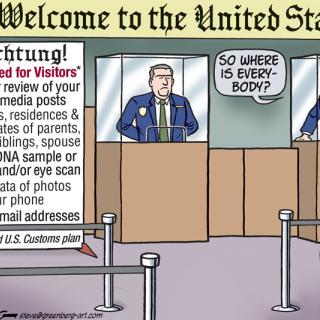My sad tales continue with new elements added every day. In chronological order, they are, so far:
First, leaders of other Columbus neighborhoods contact me. They first affirm that the analysis I presented for the University District parallels their area’s experience. They meet with me individually for cooperation, counsel, and conversation. So far, they include Weinland Park, Franklinton, and New Indianola. I encourage them to write their districts’ experiences for the Columbus Free Press.
Second, the court case of two long-time University District homeowners against NorthSteppe Realty was dismissed by the magistrate. After first court-ordered telephone “mediation” and then “in-person face-to-face conversation” without mediator or magistrate predictably failed, with no opportunity for discussion, presentation of our case, or a hearing, the magistrate dismissed the case. We learned about this accidentally days after the decision, later receiving a form letter with no explanation. For this, we had to pay a fee. I have filed a strenuous objection. I am advised, however, that the magistrate is within his rights to deny our rights.
Third, the continuing tale of institutional failure, personal success, and questions Columbus institutions and their “leaders. Early on the morning April 29 after 2:30 AM, my wife was alarmed by very loud music that she heard clearly inside our very well–built, 107-year-old house (which many of you have visited) with the doors and windows closed. Knowing that it violated the noise ordinance, she bundled up and went outside to locate the address of its source, planning to call the CPD Nonemergency line.
Not surprisingly, the location was 1972 Indianola Avenue—a NorthSteppe Realty/Stickney property (supposedly owned by the elusive Mike Butas), a very familiar address. This is among the most frequently legally offending, large student rental properties in the UD. The target of weekly or more frequent Nonemergency and 311 reports, Stickney/NorthSteppe sent them a long-overdue, but undefined and so far unenforced warning letter after Kay Bea Jones and I filed suit against them. That letter as well as “meetings” that Assistant City Attorney Steve Dunbar and Student Life hold with landlords have no effect on 1972, 1975, 1980, and 1982 Indianola, or NorthSteppe and HomeTeam.
My wife witnessed three drunken students playing bad hip-hop music (her generational judgment) at illegal volume beside an illegal open fire. She decided to try to talk to them before calling CPD. After she got their attention, they proclaimed that they had completed final exams and were celebrating—in the middle of the night. She was able to initiate a conversation. They had no awareness that they were acting illegally or might disturb either the long-time older homeowners a block away, or their student neighbors or even their own housemates.
They also commented, “Well, it’s the University District.” So much for OSU, NorthSteppe, and CPD “efforts.” The asked: “Why should we care if there are 400 people, and you’re the only one complaining?”
The fact of noise ordinances, public nuisance laws, and open fire laws was completely novel to these OSU students entering their senior year (despite NorthSteppe’s unspecific February letter and Student Life’s “knocking on doors” before Spring Football and ChittFest). They claimed that they had “a permit” for the open fire that violated the law but did not produce it, when she challenged them.
My wife reasoned with the drunks. After congratulating them on completing their exams, she led them through a discussion of both the law and incivility. They claimed to understand, and lowered the music to an acceptable level. Achieving her goal, my wife returned home before 3:00 AM. She chose not to call Nonemergency.
Why can one 71–year-old person achieve what NorthSteppe/Stickney, OSU , CPD’s occasional reminders, and ongoing meetings (I am told but with no details) with landlords held jointly by the City and OSU do not? Stickney remains on the OSU website claiming that he is “OSU Student Housing” in exchange for at least $5 million in donations, along with other listings of his firm despite many 100s of complaints, dozens of suits filed, and a pending class action suit.
I have again asked OSU and the City to explain this. They do not answer.
The problem is not one house and/or three drunken students. The problem is systemic and historical, institutional, legal, and cultural. The bottom line: illegality is condoned; money speaks.
A small number of residents—the 60s, 70s, 80s year old remnants of a once great, historic Columbus neighborhood—cannot be the City, CPD, and OSU.
Fourth, my complaints with CPD, City Attorney, and City Council about short-term riding-sharing company (Free2Drive, for example) vehicles left to litter paid parking permit areas in the University District (paralleling electronic motor scooters and rented bicycles) uncovered another area of City sanctioned violation of residents’ rights in service to an out-of-state for-profit corporation. I am one of several scholars and knowledgeable observers who adapt Columbus self-promotional slogans to declare this is part and parcel of the Columbus Way. Developers, landlords, large corporations, private promoters who falsely but profitably mascarade as the city’s “public,” mayors, and city councilors tout this endlessly.
In this case, without due process, public review, or announcement to CPD, City Council, or other responsible parties, the Columbus Department of Public Service produced “Care Share Rules and Regulations” and authorized a “permit” for Free2Move” that allows paying short-term car renters to leave vehicles in permit parking areas for which residents themselves pay, thus usurping their spaces. The illogical justification for canceling rights for which city resident must pay: “car sharing, along with shared mobility devices including scooter and bike share, and transit offer residents mobility options to get around the City.” “Mobility options”? Nothing is said about public vs. private, or who pays and who profits.
Not one word said about long-standing promises from the City to regulate this litter as other cities of comparable size with representative government and city managers do. Almost a year ago, I was told by City Council aides that regulation was coming. Who regulates the anti-regulators in the Columbus Way? Is it surprising that the demands of Short North retail establishments, scooter must be left in one designated location. Homeowners and tenants have no such rights in this city.
This is the antithesis of “public service” by Columbus’ Department of Public Service. Consistent with the Columbus Way, the City advances “private service.” Who is profiting?
Fifth, Columbus Police Department Internal Affairs. In great frustration with CPD’s frequent unresponsiveness and some dispatchers’ and officers’ ignorance about the University District and the laws, I asked my former District Commander for his advice. He immediately suggested: file a CPD Internal Affairs complaint. I did.
Unlike any other part of the City’s disorganized and disconnected maze of departments and divisions, IA responded quickly. Given the encompassing nature of my complaint, three inspectors came to my home at the same time. They were responsible and responsive, understanding and sympathetic, not in the least defensive. They admitted their own criticisms of CPD and the City. We spoke widely across a wide range of relevant and ancillary topics for almost two hours, sometimes on the record, sometimes not. At times, I felt that I was in a different city.
Of course, there are rubs. First, all three inspectors and CPD officers might at any time be transferred to another department regardless of longevity and competence. Inexplicably, they have control over that. Second, they were very clear: I should expect to wait 90-100 days before I see a report.
So goes Columbus. So goes the University District.
---------------------------------------------------------
Harvey J. Graff is Professor Emeritus of English and History and Ohio Eminent Scholar at The Ohio State University. He is the author of many books on social history. His Searching for Literacy: The Social and Intellectual Origins of Literacy Studies is due this summer. His essays appear in Inside Higher Education, Times Higher Education, Washington Monthly, Academe, Publishers Weekly, Against the Current, Columbus Free Press, among others.



